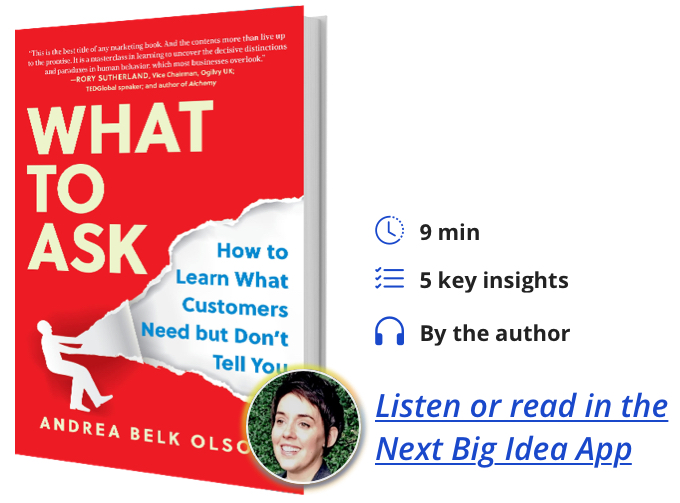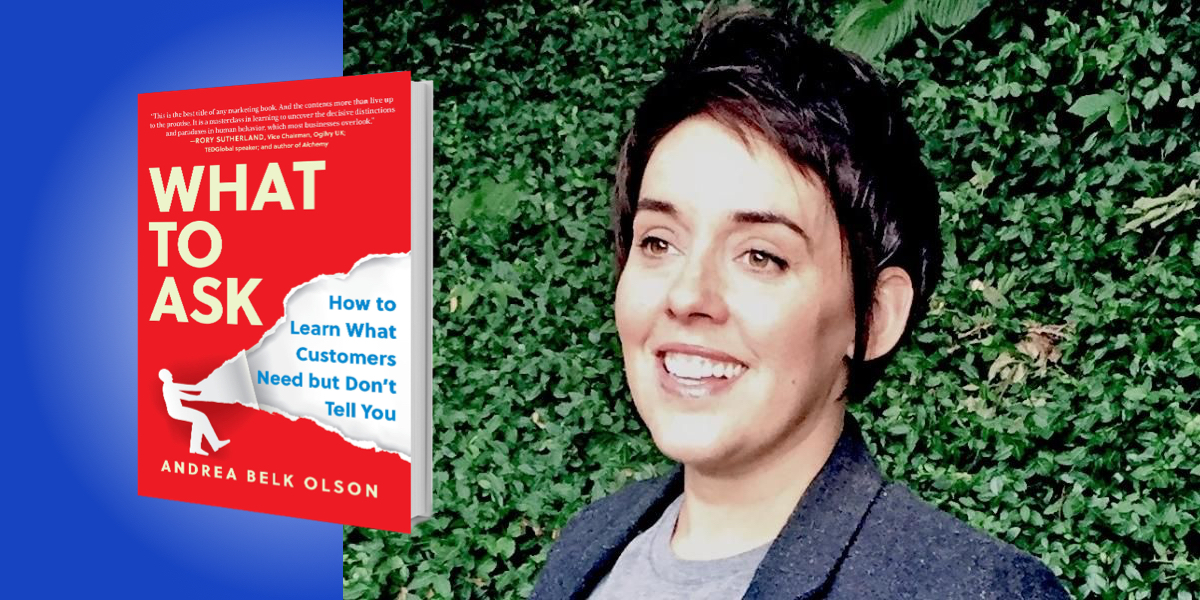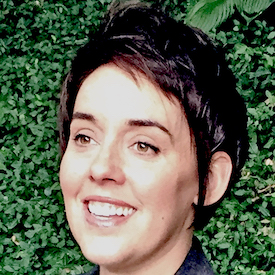Andrea Belk Olson is a behavioral scientist and CEO of Pragmadik, a consulting firm that helps businesses improve customer engagement. She is also the host of The Customer Mission podcast.
Below, Andrea shares 5 key insights from her new book, What to Ask: How to Learn What Customers Need but Don’t Tell You. Listen to the audio version—read by Andrea herself—in the Next Big Idea App.

1. Data points aren’t people.
Big data is a fantastic way to unravel big, complex, unruly problems. But data doesn’t tell the whole story, no matter how much you have at your fingertips. Take a white male, born on the East Coast, college-educated honor student, active in politics, and has a Volkswagen Beetle. This data doesn’t tell you about the person, as all these points can be associated with thousands of people—including serial killer Ted Bundy.
Data is also often historical, telling us about past behavior. It says little about why—what drove those choices. Understanding customer needs isn’t about creating a profile, but unearthing a revelation. Everyone is looking at that same data, and it’s up to you to look in places your competition isn’t to find something which no one else has uncovered. Only by engaging directly with people can you expect to understand them better.
2. Preference isn’t a predictor.
When Sony introduced the Sport Walkman in 1985, Sony conducted a focus group to get feedback on the new yellow design versus the traditional black cassette player. Every single participant preferred the yellow model. Yet, when they were offered a free Walkman for their participation, every participant chose a black one. This is the challenge: preference doesn’t predict behavior. Asking a customer if they prefer option A to option B is one thing. Asking them to predict future wants and needs will generate misleading outcomes if taken at face value.
“Preference doesn’t predict behavior.”
Today, we can instantly conduct surveys to gather customer validation of an idea and justify further investment into it. But behavioral science researchers have found that human preferences are often temporary and are easily manipulated. Preferences change as context and goals change. What we believe is rational choice—the idea that preferences are stable, consistent, and unambiguous—overlooks human nature. We are not robots.
3. Our mindset can be biased.
When sales numbers miss their target or competitors start eating into market share, company leaders put pressure on turning things around. Things are viewed as “we need” problems: We need more sales. We need to be more competitive. We need innovations to better differentiate from competitors. Yet hyper-focusing on what we need prevents seeing what customers need.
Shifting this mindset takes more than a directive from organizational leadership because capturing useful customer insights is hard. Cognitive biases can cause interviewers to filter out lines of questioning, simply because of preconceived notions. For example, a financial institution assumed their older clients wouldn’t consider digital and online tools important on their list of needs. However, in a series of unbiased interviews, they found that while older clients didn’t use technology often, they cared about it immensely because their assistants used it. They equated a company having state-of-the-art technology as an up-to-date business.
“Hyper-focusing on what we need prevents seeing what customers need.”
4. Insights are everyone’s job.
Rick Rubin, American record producer and former co-president of Columbia Records, said, “If you only know your customers through their transactional data . . . if you only speak to your customers to hear what they think about you, rather than understand what you don’t know about them . . . if you only talk about your customers in generic terms . . . if you think your customers’ lives have remained the same for over a year . . . if you use trend reports as a substitute for knowing your customers’ future habits and behaviors . . . if you only talk to the same customers in the same markets . . . if you only care about how to get your customers to buy more of what you’re selling . . . if you call your customers ‘purchasers’ . . . then I assure you, you don’t know or truly care about your customers.”
Caring requires knowing. Knowing requires understanding people as individuals, not as a revenue source. Achieving this means shrinking the gap between you and your customers. Getting as close as possible requires an organizational structure that enables doing so. This includes making capturing feedback everyone’s job. It requires making customer engagement the priority. It requires creating time and opportunity for every employee to capture input. Insights must be part of the job description.
“Caring requires knowing. Knowing requires understanding people as individuals, not as a revenue source.”
5. Kill your mission statement.
Traditional mission statements are mostly filled with meaningless platitudes and buzzwords. Do you even know your company’s mission statement? More importantly, do you believe it? If you can’t relate to it or articulate its essence, then it won’t mean much to anyone else. Mission statements shouldn’t start with your company, but your customer.
A customer mission resets the goalposts, helping shift the organizational mindset outward to the customer, rather than inward to the company. A customer mission isn’t about the company, your process, or generic corporate speak. There are four distinct components of a customer mission.
First, articulate what your customers want to achieve.
Second, articulate how your customers want to be served.
Third, articulate the impact you have on customers to fulfill their objectives.
And fourth, include why customers care about what you do. This provides your team direction and purpose in a much clearer and actionable way.
To listen to the audio version read by author Andrea Belk Olson, download the Next Big Idea App today:





























